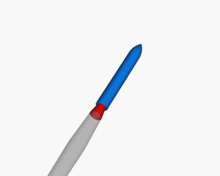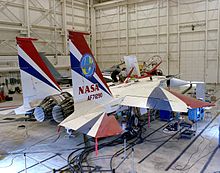Thrust vector control

A thrust vector control enables steering movements by specifically directing the exhaust gas jet of a drive. It is mostly used on military aircraft and missiles to improve maneuverability. This can be achieved by using jet rudders, deflection surfaces at the nozzle outlet or swiveling the entire nozzle .
In addition to conventionally taking off aircraft, thrust vector control is also used in vertical take- offs; in this case the aircraft is carried by the vertical downwardly steered thrust during vertical take-off. For level flight, the nozzles are swiveled into the appropriate position to give the aircraft propulsion; the lift is then generated in a conventional manner by the wings.
technology
A thrust vector control for long-range missiles is necessary , since aerodynamic control is not possible during the launch phase or in the vacuum of space. On smaller missiles and fighter jets , it can support or replace the rudders to increase maneuverability. In the case of an aircraft, it enables much higher angles of attack , so controllable flight conditions beyond the critical angle of attack are possible. In the German-American project Rockwell-MBB X-31 , for example, angles of attack of up to 70 ° were achieved without losing control of the aircraft.
The biggest problem in the series production of aircraft and space vehicles with 3D thrust vector control is the thermal load on the nozzles, which requires materials that have only been available at acceptable prices since the end of the 20th century.
2D and 3D control
The thrust vector control is divided into 2D and 3D variants. If the exhaust gas jet is deflected in only one plane, this is referred to as a 2D thrust vector, whereas a nozzle that can be pivoted in all directions is referred to as a 3D thrust vector. The thrust reverser for braking aircraft is also partially defined as a kind of 2D thrust vector control and has been used in civil aviation since the late 1950s (the first civil aircraft with a standard thrust reverser was the Boeing 707 ).
One of the first machines to have 2D thrust vector control was the British whiz kid Hawker P.1127 . This formed the basis for the later Harrier , which also used 2D thrust vector control for vertical take-offs and landings . Since the thrust deflector can also be started at any intermediate position, so-called jump starts with a short roll-on distance are also possible with high payload requirements. On board an aircraft carrier, this can be done with the help of "ski jumps". In modern combat aircraft 2D thrust vectoring, in addition to the advantages for takeoffs and landings, is primarily to improve the air combat skills in " Dog Fight " is used. The pitching movements are improved, as are the rolling movements if the machine has at least two engines. On the other hand, a 2D thrust vector control has no effect on yaw movements . The first series combat aircraft to be equipped with such a control as standard was the American F-22 Raptor , which entered service in 2005 .
A 3D thrust vector control also directs the thrust jet in yaw motion, which allows enormous maneuverability and thus enables decisive advantages in close-range combat.
The Su-30MKI, which has been delivered to the Indian Air Force since 2002, is equipped with a 3D thrust vector control. The following models are equipped with a 2D or 3D thrust vector control.
VTOL
- Bell Model 65
- Bell X-14
- Bell Boeing V-22
- Boeing X-32
- Dornier Thu 31
- EEA VJ 101
- Harrier Jump Jet
- Lockheed Martin F-35B Lightning II
- Yakovlev Yak-36
- Yakovlev Yak-38
- Yakovlev Yak-141
maneuverability
2D thrust vector control
- McDonnell Douglas F-15 STOL / MTD (experimental)
- Lockheed Martin F-22 Raptor (pitch and roll only)
- McDonnell Douglas X-36 (yaw only)
3D thrust vector control
- Sukhoi Su-30MKI / MKM / MKA / SM
- Sukhoi Su-35S
- Sukhoi Su-37 (experimental)
- Sukhoi Su-57
- Mikoyan-Gurevich MiG-35 (MiG-29OVT)
- McDonnell Douglas F-15 ACTIVE (experimental, 1993-1999)
- General Dynamics F-16 VISTA (experimental)
- Rockwell-MBB X-31 (experimental)
- McDonnell Douglas F-18 HARV (experimental)
- Mitsubishi X-2 (experimental)
Missile technology
There are two main types of thrust vector controls that have prevailed for missiles:
- Pivoting of the entire gimbal-mounted rocket engine in two axes
- Pivoting the nozzle, this is mainly used with solid fuel boosters (e.g. Space Shuttle Solid Rocket Booster ), as it is not possible to pivot the entire booster.
The following are other types of thrust vector control that are not widely used:
- Small swiveling auxiliary engines, so-called vernier nozzles ( e.g. Soyuz )
- Injection of liquid into the side part of the nozzle, the evaporation of the liquid influences the expansion of the combustion gases and thus manipulates the thrust vector ( UGM-27 Polaris ).
- Rotatable thruster in the exhaust gas flow ( A4 )
- Forcing air into the side part of the nozzle, the change in pressure also changes the thrust vector.
- The exhaust gases from the gas generator (a device that burns fuel to provide energy for the turbo pumps) are directed to a pivoting nozzle, which in turn creates a variable vector of thrust.
Actuators
Hydraulic or electrical actuators are mainly used to pivot the nozzles. For very large engines (the first stage in each case: Ariane 5 , Delta IV , Atlas , Space Shuttle ), hydraulic actuators are used due to the high forces required. In the upper levels (for example the Ariane 5 and Delta IV), electrical actuators are used, as they are more energy efficient and easier to store and install (no hydraulic oil).
Energy sources for thrust vector systems
Chemically driven pumps are usually used as the energy source for hydraulic thrust vector actuators (e.g. space shuttle). In the Saturn V rocket , the entire thrust vector control system was driven by the fuel system, so the turbo pump, which was already in place, provided the required energy and replaced a separate drive system. However, the weight savings were offset by the requirement that the entire hydraulic system, especially the seals, had to be compatible with the fuel.
Hydraulic accumulators are another energy source for thrust vector control. The Ariane 5 uses a spherical tank which contains the hydraulic oil and is pressurized by nitrogen. The existing pressure is sufficient to provide enough energy for a start. The used oil is burned in the exhaust gas jet.
Platforms
| template | Type | Freedom of movement |
Engine | Steering effect 1 | First flight |
|---|---|---|---|---|---|
| F-15 S / MDT | 2D | 20 ° | 2 × Pratt & Whitney F100-PW-200 | 2 × 23.6 kN | September 1988 |
| F-15 ACTIVE | 3D | 20 ° | 2 × Pratt & Whitney F100-PW-299 | 2 × 28.7 kN | March 1996 |
| F-16 MATV | 20 ° | General Electric F110-GE-100 | 27.8 kN | April 1992 | |
|
F-16 Fighting Falcon with " AVEN " |
20 ° | General Electric F110-GE-129 | 28.7 kN | July 1993 | |
| F / A-18 HARV | 25 ° | 2 × General Electric F404-GE-400 | 2 × 21.9 kN | April 1987 | |
| F-22 Raptor | 2D | 20 ° | 2 × Pratt & Whitney F119-PW-100 | 2 × 34.7 kN | September 1997 |
| Hawker Siddeley Harrier | k. A. | 1 × Rolls-Royce Pegasus Mk-103 turbofan engine | 2 × 95.65 kN | December 1967 | |
| X-31 EFM | 3D | k. A. | General Electric F404-GE-400 | - | October 1990 |
| MiG-29OWT | 15 ° vertical
8 ° horizontal |
2 × Klimow RD-133 | 2 × 14.7 kN | 2003 | |
| Su-30MKI | 15 ° vertical
8 ° horizontal |
2 × Saturn AL-31FP | 2 × 20.5 kN | July 1997 | |
| Su-35BM | 15 ° vertical 8 ° horizontal |
2 × Saturn-117S / AL-41F1A | vertical 2 × 23.7 kN horizontal 2 × 12.6 kN |
February 2008 |
F S ... steering effect of the thrust vector control at maximum deflection (in N)
F T ... maximum thrust of the engine in afterburner operation (in N)
See also
Individual evidence
- ↑ Thrust vector control via gas generator exhaust gases ( Memento from April 29, 2011 in the Internet Archive ) (PDF; 3 MB)
- ↑ Shuttle drive system for thrust vector control
- ↑ F-16.net
- ↑ Jane's Aero Engines 2002
- ↑ NASA factsheet
- ↑ GlobalSecurity.com



